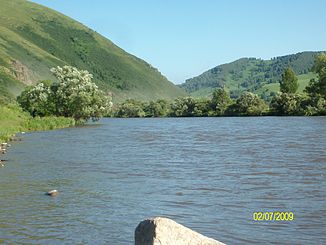Anui
|
Anui Ану́й, Ануй |
||
|
Anui near Solonezhnoye (Altai region) |
||
| Data | ||
| Water code | RU : 13010200312115100008214 | |
| location | Republic of Altai , Altai ( Russia ) | |
| River system | If | |
| Drain over | Whether → Arctic Ocean | |
| source | Anuikamm in the Altai 51 ° 6 ′ 49 ″ N , 85 ° 1 ′ 23 ″ E |
|
| Source height | approx. 1220 m | |
| muzzle |
Whether southwest of Biysk coordinates: 52 ° 24 '12 " N , 84 ° 43' 33" E 52 ° 24 '12 " N , 84 ° 43' 33" E |
|
| Mouth height | 158 m | |
| Height difference | approx. 1062 m | |
| Bottom slope | approx. 3.2 ‰ | |
| length | 327 km | |
| Catchment area | 6930 km² | |
| Discharge at the Starotyryschkino A Eo gauge : 6850 km² Location: 10 km above the mouth |
MQ 1936/1987 Mq 1936/1987 |
36.1 m³ / s 5.3 l / (s km²) |
| Communities | Solonezhnoye , Petropavlovskoye | |
The Anui ( Russian Ану́й ) is a 327 km long left tributary of the Ob in the Altai and its foreland in southwest Siberia ( Russia ).
course
The Anui rises in about 1220 m at the southeast end of the almost 1700 m high Anuikamm ridge named after the river in the northwestern part of the Russian Altai, a few kilometers above the village of Verkhni Beloanui. It initially flows in a north-westerly direction through a valley that separates the Anuikamm from the Baschtschelakkamm, which runs parallel to the south-west. After about 40 kilometers and flowing through the villages of Bely Anui and Tschorny Anui, the Anui leaves the Altai Republic and reaches the Altai region to the north . The entire upper course of the river is also called White Anui (Bely Anui) , until it merges with the significantly smaller Black Anui ( Tschorny Anui , also Tschernowoi Anui ) flowing in from the left a good 30 km after reaching the Altai region and a few kilometers above the village and Rajonverwaltungszentrums Soloneschnoje .
At the village of Antonjewskoje, the river finally enters the Altai foothills at a height of around 250 m and turns in a north-easterly to easterly direction. It flows through the hilly steppe landscape in a meandering manner , about 60 km roughly parallel to the Ob and 20 km away from it, but in the opposite direction. The wide valleys of Ob and Anui are separated in this area by the Kolywanski Uwal mountain range, which is around 100 m higher. At the village of Anuiskoje, the Anui turns north again and flows into the Ob at Ust-Anui, southwest of the city of Bijsk , just 20 km below its origin from Bija and Katun .
The Anui has no major tributaries. There are no cities on the river, but the larger settlements and district administrative centers of Solonezhnoye and Petropavlovskoye .
Hydrography
The catchment area of the Anui covers 6930 km².
The mean annual runoff at Starotyryschkino, about 10 kilometers above the mouth, is 36.1 m³ / s with a monthly minimum of 6.9 m³ / s in February and a maximum of 123 m³ / s in April.
Above the mouth, the Anui is over 100 meters wide and up to two meters deep; its flow velocity here is 0.7 m / s.
The Anui freezes between November and April.
Infrastructure
The Anui is not navigable.
The area through which the Anui flows, especially in the area of the intensively agriculturally used Altai foreland, is relatively densely populated; there are many villages on its banks. It is accessed by a number of partly unpaved roads, such as from Bystry Istok (district center on the Ob) via Petropavlovskoje to Ust-Kalmanka (district center on the Charysch ) or from Solonezhnye upstream to the upper reaches of the Anui and on to Ust-Kan .
Web links
Individual evidence
- ↑ a b Anui in the State Water Directory of the Russian Federation (Russian)
- ↑ a b Article Anui in the Great Soviet Encyclopedia (BSE) , 3rd edition 1969–1978 (Russian)
- ↑ a b Anui at the Starotyryschkino gauge - hydrographic data at R-ArcticNET

